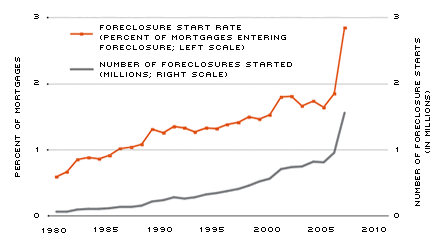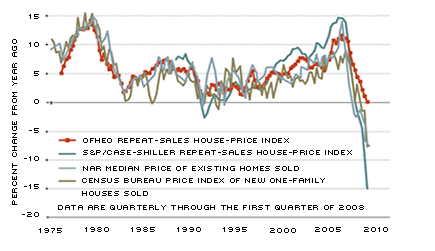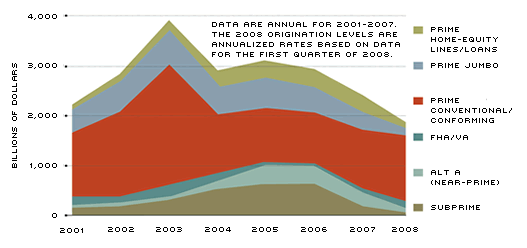The Mortgage Crisis: Let Markets Work, But Compensate the Truly Needy
Recent mortgage-foreclosure rates are the highest since the 1930s.1 Yet, large-scale government interventions directly in housing or mortgage markets—such as government purchases of delinquent mortgages or vacant houses, involuntary mortgage modifications, or outright mortgage-foreclosure bans—are not necessarily the best policy responses. From the perspective of maximizing long-run economic efficiency, it would be better to allow housing and mortgage markets to sort themselves out, as painful as that may be. Politicians can decide whether and how to help those who were made truly needy by this crisis.
In order to minimize future boom-and-bust cycles in housing and mortgage markets, makers of public policy also should seek to eliminate risk-taking distortions that have become evident recently and to level the playing field for all market participants to the greatest extent possible.
The Mortgage-Foreclosure Crisis
Mortgage foreclosures had been increasing gradually for many years, but they spiked sharply upward beginning in 2006. Almost 3 percent of first-lien mortgages in the U.S. entered the foreclosure process during 2007, affecting about 1.6 million households (Figure 1).2 Conditions in housing and mortgage markets remain stressed in mid-2008, suggesting that foreclosure rates this year could be even higher than last year.3 Based on various data sources, mortgage-foreclosure rates probably have not been this high in the U.S. since the Great Depression during the early 1930s.
Among states in the Federal Reserve’s Eighth District, Indiana experienced the highest foreclosure-start rate last year (Table 1). About 4.34 percent of all Indiana mortgages entered foreclosure, representing more than 45,000 households. Illinois, Mississippi and Kentucky also experienced foreclosure rates higher than the national average, while Tennessee, Missouri and Arkansas foreclosure rates were below the national average. In each case, the 2007 rate was the highest for that state in many decades.
Causes of the Crisis
Two potential causes of debt default are an interruption of the borrower’s income and unaffordable payments. For most households, the primary source of debt repayment is earnings from employment. Becoming unemployed, therefore, is likely to increase the risk of default considerably. A likely cause of unaffordable mortgage payments is a high interest rate on a fixed-rate mortgage or a high reset rate on an adjustable-rate mortgage. Recent research suggests that neither of these factors played a large role in the 2006-07 increase in mortgage-foreclosure rates. (See sidebar below.)
Three important trends combined to create the current wave of foreclosures:
1) An increasing number of risky mortgages. In 2001, fewer than 10 percent of outstanding mortgages were nonprime, a category comprising subprime and Alt-A (Alternative-A), or near-prime, mortgages.4
Their share grew rapidly in the years that followed, however. Figure 2 shows that subprime and near-prime mortgages reached almost 34 percent of all mortgage originations during the peak year of 2006. After several years of rapid growth, about 13 percent of outstanding first-lien mortgage loans were subprime at the end of 2007, and a further 10 percent were near-prime.5 Thus, almost one-quarter of mortgages were conventional (not guaranteed by the federal government) nonprime loans by late 2007, compared with a mid-single-digit share a decade earlier.
Subprime loans are characterized by weaker borrowers (for example, low credit scores), and near-prime loans are characterized by riskier loan structures (for example, limited documentation). Lenders attempt to compensate for increased risk of default by charging higher interest rates. Even if the loan underwriting is done properly, lenders expect the default rate to be higher on these loans. Higher interest payments by borrowers who do not default are expected to offset the losses on defaulting loans. Thus, higher default rates should be expected as the mix of outstanding mortgages shifts toward riskier categories.
2) The riskiness of the typical nonprime mortgage loan increased. There is evidence that the amount of risk being assumed by a typical nonprime borrower increased steadily during recent years. One indicator of increasing risk is greater borrower leverage. About 45 percent of subprime borrowers in 2001 had less than 20 percent equity in their houses at the time they took out the mortgage. Five years later, 58 percent were in this category, an increase of 13 percentage points.
3) House prices stopped rising rapidly in 2006 and began to decline in many areas. A common characteristic of most borrowers with risky mortgages (including those with subprime and near-prime mortgages) is that their ability and willingness to remain current on payments is extremely sensitive to the rate of appreciation of their house’s market value.6 As long as house prices are rising, even financially weak borrowers who are facing cash-flow problems can avoid default by selling the property or refinancing the mortgage. Rising house prices create additional homeowners’ equity, which bails out both the lender and the borrower.
When house prices stop rising or actually fall, the sale-or-refinancing escape hatch begins to close. Any financial setback can translate quickly into mortgage delinquency and, sometimes, into default. Falling house prices tend to coincide with slow markets, when houses remain unsold for long periods (due to the unwillingness of many sellers to lower their asking prices sufficiently to meet the prices bid by potential buyers). Inability to sell quickly increases default risk further.
Nationwide average rates of house-price appreciation declined in 2006 and 2007 from double-digit rates of increase experienced earlier (Figure 3). In areas that previously had experienced extremely rapid price increases, such as California and Florida, deceleration turned into outright price declines. Among nonprime borrowers, the most vulnerable were those who bought their houses with little or no down payment or refinanced into a nonprime loan just before the house-price boom ended (2005 or 2006). In fact, statistical evidence shows that these later cohorts of borrowers are defaulting in large numbers now—regardless of local unemployment trends and often before their mortgage interest rates were due to reset.7
These three trends—a rising number of risky loans, increasing risk levels in these loans and decelerating house prices—are interconnected. Increased availability of nonprime mortgages during the last decade was associated with vastly increased nonprime-mortgage borrowing and faster rates of house-price appreciation. Rising house prices, in turn, encouraged more nonprime lending and borrowing on ever-riskier terms—after all, loan performance had been good and homeowners’ equity appeared healthy and growing. Unfortunately, the rising tide of ever-riskier mortgages has unleashed a flood of defaults as house price appreciation stalled and went into reverse.
A Case for Correction—or Not
From the perspective of maximizing long-run economic efficiency, it is better to allow housing and mortgage markets to sort themselves out as quickly as possible, rather than intervening to prevent house prices and homebuilding activity from finding their natural levels. It is unlikely that any public policies could have prevented house prices from declining and many borrowers from defaulting during recent years, given the scale of apparent overvaluation and overbuilding in housing markets, together with the large number of risky mortgages taken on by many households. Any delay in necessary adjustments would be temporary, at best, and could exacerbate the problems, at worst. For example, artificially maintaining house prices at levels above those that a free-functioning market would produce could induce homebuilders to continue adding to the supply of houses. Ultimately, this would drive house prices down even further.
A preference for nonintervention in markets does not mean that economists are heartless, however. A policymaking corollary to the economic rule of laissez-faire in markets is the so-called compensation principle.9 This states that a portion of the economic gains achieved by allowing markets to work unimpeded can and should be used to compensate the losers—individuals who are harmed by the adjustment process itself.
In addition to compensating those adversely and, perhaps, unfairly affected by necessary market corrections, an economic approach to the mortgage-foreclosure crisis would seek to reduce or eliminate market distortions that may have contributed to the boom and bust in the first place. The key underlying causes of the current spike in mortgage foreclosures are an increasing number of risky mortgages, greater risk-taking by lenders and borrowers, and a historic housing boom turned to bust. Was each of these a bad thing by itself, needing correction?
Underlying cause No. 1—an increasing number of risky mortgages. It is not obvious that an increasing number of risky mortgages is a problem that needs to be fixed. The increased number of risky mortgages in recent years represents an increase in the number of households that were able to access the mortgage market, as well as a larger variety of ways to borrow.
In some cases, these nontraditional borrowers were riskier, which resulted in higher expected delinquency and default rates. But a higher rate of default is not by itself a reason to reduce access to credit.
For all its flaws, the boom in nonprime mortgage lending coincided with, and may have contributed to, an increase in the homeownership rate. After reaching 64.3 percent in 1969, the homeownership rate fluctuated, but did not significantly surpass the 1969 level until 1995. During the following decade, as the nonprime mortgage sector expanded, the homeownership rate rose to 69 percent.
Some of these new homeowners overextended themselves, and abuses appear to have been committed by some mortgage brokers, other lenders, investors, appraisers and others. Oversight in the mortgage market should be strengthened and abuses eliminated, but the goal of extended access to mortgage credit surely is a reasonable one for public policy. Because the private market for nonprime mortgages is not likely to recover quickly, there is a case for bolstering government agencies and programs that facilitate widespread access to decent housing and mortgage credit. These programs include Federal Housing Administration and Veterans Administration mortgage guarantees, as well as housing assistance from the Department of Housing and Urban Development (HUD), both for renters and owner-occupiers.
Underlying cause No. 2—greater risk-taking by borrowers and lenders. As long as both borrowers and lenders were fully aware of the greater risks they were taking, there is, once again, no problem to fix. It would be counterproductive to ban outright any practices and contracts that well-informed buyers and sellers are willing to accept. Of course, many mortgage borrowers probably were not fully informed or as sophisticated as lenders were. Financial literacy desperately needs improvement. Consumer-protection regulations, including disclosure requirements and enforceable penalties that are consistently assessed against bad actors, are important in leveling the playing field. The Federal Reserve actively promotes greater financial literacy, and the Fed has revised Regulation Z, which implements the Truth In Lending Act, to strengthen consumer protections in both mortgage and credit-card lending. In addition, more work should be done in strengthening enforcement mechanisms available to both federal and state agencies.
As for excessive risk-taking by lenders and investors, the best disciplining device is market discipline—the harsh punishment meted out by stock and bond markets after financial firms make poor risk decisions. The financial pain suffered by mortgage lenders and investors is measured in the hundreds of billions of dollars already. No doubt, investors’ appetite for making risky mortgage loans is much reduced today. It is unlikely that as many risky mortgages will be offered in the future as occurred during the early 2000s.
Underlying cause No. 3—a historic housing boom turned to bust. As is true for the mortgage market, housing markets also are most efficient when allowed to function unimpeded—as long as the preconditions for competitive markets are met, of course. Is the housing market capable of functioning efficiently?
There are potentially many buyers and sellers of existing houses, while the homebuilding industry consists of low barriers to entry (and exit) and vigorous competition. In some communities, land-use or other building restrictions put artificial constraints on increasing the supply of housing units, but this means simply that house prices must bear more of the burden of equating supply and demand, rather than relying on changes in the housing stock. In either type of market—supply-constrained or unconstrained—there is no compelling reason why market processes will produce inefficient outcomes. Tax distortions may contribute to overinvestment in housing, but houses, once built, trade in relatively free markets.
The recent housing boom ranks among the most vigorous in recent decades, measured both in terms of increased home-building activity and house-price gains outstripping income growth. The U.S. was not unique in this respect, as many countries experienced unusually large increases in both home-building activity and house prices.10 The national housing bust that is unfolding now is likewise large in comparison with recent downturns, but is unexceptional when compared with experiences in many other countries or with some prior regional housing busts in the U.S.—for example, in the manufacturing-intensive states in the early 1980s, in the energy-producing states in the late 1980s, or in the Northeast and California in the early 1990s.11
Policy Responses
A key step in sound economic policymaking is to determine if it is likely that government actions would fix the problems. After all, intervening can make the situation worse—for example, by distorting housing or mortgage markets so much that eventual recovery is more difficult or future performance is compromised; by using public funds inefficiently and shifting the cost onto future taxpayers who are not represented in today’s debate; or by increasing moral hazard (the expectation of a future bailout), which could make future crises larger and more likely.
Based on the previous discussion of the underlying causes of the mortgage-foreclosure crisis, the scope for welfare-enhancing direct interventions into housing and mortgage markets appears limited. Increased government funding of housing and mortgage assistance to households not served by the prime mortgage market—via FHA and VA loan guarantees, for example—might temporarily replace some of the private nonprime mortgage markets that have collapsed. A renewed emphasis on public-sector assistance for housing and on mortgage access for underserved households also would address the presence of predatory lenders who take advantage of uninformed or financially unsophisticated borrowers. Stronger disclosure regulations and stiffer penalties also are needed to reduce the information deficit many households suffer.
Conclusion
House prices in many parts of the country may fall from their peak levels in 2006 or 2007 by the largest amount in several decades. Millions of households already have lost their houses through foreclosure, and millions more probably will follow. What should governments do, if anything?
From a purely economic perspective, it is desirable that overvalued house prices decline. Artificially high house prices send the wrong signal to homebuilders, who will make the ultimate correction even worse by supplying even more unneeded houses. Foreclosures are necessary to ensure that mortgage markets function effectively. The ability of a lender to seize the borrower’s collateral is what keeps a mortgage borrower’s interest rate far below credit-card rates. Without the possibility of foreclosure, mortgage rates would be much, much higher because the borrower’s incentive to pay back the loan would be diminished greatly.
The financial distress to borrowers and communities caused by foreclosures should be addressed directly. A stronger social safety net—including measures such as income support, vouchers to guarantee access to decent housing and assistance in re-establishing household financial stability—is the most direct way to deal with the fallout from mortgage foreclosures. Local communities can be supported through direct grants from the federal government to replace tax revenue lost as a result of slumping local housing markets.
Economically efficient public policy attacks the underlying causes of a crisis directly, rather than approaching problems indirectly or by dealing only with symptoms. By allowing markets to sort themselves out quickly, a basis for sustainable homeownership and responsible mortgage lending can be re-established.
Foreclosure Start During 2007 in Eighth District States
| Percent of mortgages entering foreclosure at MBA-surveyed lenders | Estimated number of mortgages entering foreclosure at all lenders | |
|---|---|---|
| Indiana |
4.34
|
45,516
|
| Mississippi |
3.49
|
10,625
|
| Illinois |
3.05
|
63,178
|
| Kentucky |
2.90
|
15,420
|
| Tennessee |
2.62
|
27,331
|
| Missouri |
2.61
|
27,970
|
| Arkansas |
2.05
|
7,611
|
| USA |
2.84
|
1,554,828
|
SOURCES: Mortgage Bankers Association (MBA) and author’s estimates.
The estimated numbers of foreclosure starts are adjusted upward using the assumption that the numbers reported by MBA represent 84 percent of the true amount.
Annual Rate and Number of Foreclosure Starts

SOURCES: Mortgage Bankers Association (MBA) and author's estimates.
Annual number of foreclosure starts is adjusted upward to reflect the partial coverage (about 84 percent ) of the MBA survey.
Indexes of House-Price Appreciation

SOURCES: Office of Federal Housing Enterprise Oversight (OFHEO); National Association of Realtors (NAR); U.S. Bureau of the Census.
Endnotes
- See Bernanke. [back to text]
- This estimate is based on the Mortgage Bankers Association National Delinquency Survey, which covers about 84 percent of all first-lien mortgages. The MBA survey identified 1,306,000 foreclosure starts in 2007, or 2.84 percent of all mortgages. If nonsurveyed lenders experienced comparable foreclosure rates, the nationwide total of foreclosure starts in 2007 would be about 1,555,000. [back to text]
- Not all foreclosure starts result in foreclosure. A borrower entering foreclosure may become current on payments again; the mortgage terms may be renegotiated to become affordable; or the buyer may sell the house and pay off the loan. [back to text]
- There is no precise definition of a subprime or near-prime mortgage loan. In general terms, subprime loans are the riskiest, prime loans are the least risky and near-prime loans are in between. See Emmons and Sengupta. [back to text]
- See Mortgage Foreclosure Project Research Committee of the Federal Reserve. [back to text]
- See Gerardi, Shapiro and Willen. [back to text]
- See Demyanyk and Van Hemert. [back to text]
- See Mian and Sufi. [back to text]
- See Stiglitz. [back to text]
- See International Monetary Fund. [back to text]
- See Wheelock. [back to text]
- See Demyanyk and Van Hemert. [back to text]
- See Demyanyk and Van Hemert; and Gerardi, Shapiro and Willen. [back to text]
References
Bernanke, Ben S. “Mortgage Delinquencies and Foreclosures.” Speech at the Columbia Business School’s 32nd Annual Dinner, New York, May 5, 2008.
Demyanyk, Yuliya; and Van Hemert, Otto. “Understanding the Subprime Mortgage Crisis.” Working Paper 2007-05, Federal Reserve Bank of St. Louis, 2008.
Emmons, William; and Sengupta, Rajdeep. “What is Subprime Lending?” Federal Reserve Bank of St. Louis Monetary Trends, June 2007.
Gerardi, Kristopher; Shapiro, Adam Hale; and Willen, Paul S. “Subprime Outcomes: Risky Mortgages, Homeownership Experiences, and Foreclosures.” Working Paper 07-15, Federal Reserve Bank of Boston, 2008.
Inside Mortgage Finance. “Non-Conforming Mortgage Market Was Hammered in 4Q07, A Slow Start in ’08.” Feb. 8, 2008, pp. 3-6.
International Monetary Fund. World Economic Outlook, April 2008. Chapter 3.
Mian, Atif R.; and Sufi, Amir. “The Consequences of Mortgage Credit Expansion: Evidence from the 2007 Mortgage Default Crisis.” Working Paper, University of Chicago Graduate School of Business, 2008.
Mortgage Bankers Association. “National Delinquency Survey.” Fourth Quarter, 2007.
Mortgage Foreclosure Project Research Committee, “Mortgage Foreclosure Knowledge Snapshot,” Federal Reserve Conference of Presidents Working Paper, March 2008.
Stiglitz, Joseph E. Economics of the Public Sector. Second Edition. New York: W.W. Norton, 1988. Chapter 4.
Wheelock, David C. “What Happens to Banks When House Prices Fall? U.S. Regional Housing Busts of the 1980s and 1990s.” Federal Reserve Bank of St. Louis Review, September/October 2006, Vol. 88, No. 5, pp. 413-29.
Views expressed in Regional Economist are not necessarily those of the St. Louis Fed or Federal Reserve System.
For the latest insights from our economists and other St. Louis Fed experts, visit On the Economy and subscribe.
Email Us



